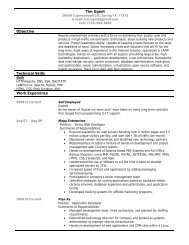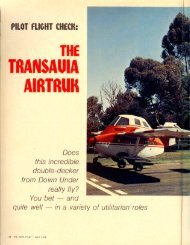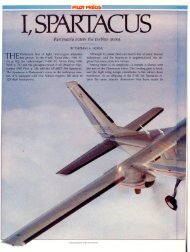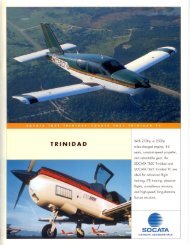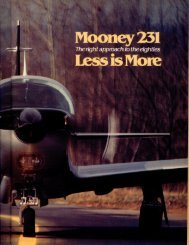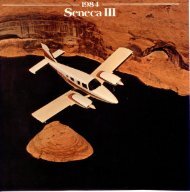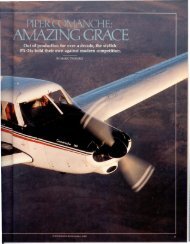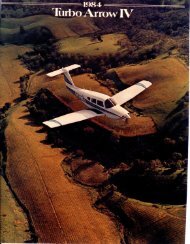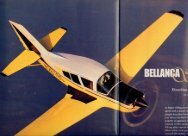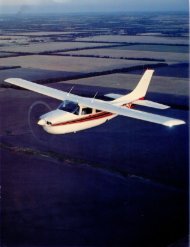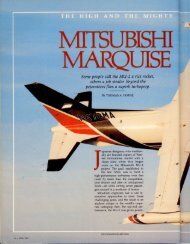A Merlin by any other name - Aero Resources Inc
A Merlin by any other name - Aero Resources Inc
A Merlin by any other name - Aero Resources Inc
- No tags were found...
Create successful ePaper yourself
Turn your PDF publications into a flip-book with our unique Google optimized e-Paper software.
model called <strong>Merlin</strong>, the mc (modeldesignation is SA227-Tf), which wasintroduced in the fall of 1980. It hadsignificant changes over previousmodels that improved operational flexibilityand utility, maintainability andoperating characteristics. It was alsothe first g'eneral aviation aircraft certificatedto Special Federal Aviation Regu-'lation (SFAR) 41. To oversimplify, thiscategory provides a way to get aroundthe ancient and arbitrary 12,500 poundmaximum takeoff or gross weight limitthat separates light aircraft from airtransport category aircraft. For operatorsof approved aircraft, it expandsoperational options, providing increasesin both payload and range. Forthe <strong>Merlin</strong>, it expanded the envelope<strong>by</strong> 730 pounds: maximum takeoffweight increased from 12,500 to 13,230(maximum ramp weight is 13,330pounds; maximum landing weight is13,230 pounds).The tradeoff for greater operationalflexibility is more stringent standardsfor structures, systems, operations andcrew qualification. Performance requirementsfor such parameters as balancedfield length and single engineclimb are more demanding. Fire protectionstandards are higher. For instance,fire detection and extinguishingsystems must be installed in theengine compartments, and fire containmentproperties must be satisfactorilydemonstrated (fire walls are stainlesssteel in the <strong>Merlin</strong> IIIC/300).Flammable fluid lines must be isolatedfrom electrical sources. Interior materialsmust meet air carrier fire resistancestandards.Any aircraft operated at weightsabove 12,500 pounds requires the pilotin command to be type rated. Initially,<strong>Merlin</strong>s that were operated underSFAR 41 required a two man crew, althoughthey now are approved for singlepilot operation.In terms of structure and systems,the <strong>Merlin</strong>s have reflected the designphilosophies of heavy transports morethan some <strong>other</strong> general aviation turboprops.In its current form, it includesa fail-safe primary structure,fail-safe structures at all critical loadpoints, multiple spar webs and <strong>other</strong>features to ensure that, in the event offailure of or damage to <strong>any</strong> critical airframeelement, structural integrity ismaintained. The airframe has a safelife of 35,000 hours. Environmentaland operational systems are dualthroughout. The electrical system employsthree buses.The horizontal stabilizer is mountedwell above the fuselage, basically acruciform tail. It is pivoted near therear spar, and the entire surface moveswith pitch trim commands throughelectrically operated dual jack screws.There are visual and aural trim indicatorsin the cockpit. The pilot and copilottrim systems are separate.The primary flight controls are actuated<strong>by</strong> directly linked push rods. Theslotted flaps are hydraulically actuatedand mechanically linked to preclude asplit flap condition.Earlier <strong>Merlin</strong>s had a relatively slow,high-drag gear extension and retractionsystem that was gradually improvedthrough several modelchanges. The mc iptroduced an improvedsystem coupled with a new enginecowl design that greatly improvedserviceability and access (the comp<strong>any</strong>claims that an engine can be disconnectedand removed in less than 30minutes without requiring rerigging afterreplacement). The new gear systemoperates more quickly. It also eliminatedthe high-drag door on the nose-AOPA PilOT • 67



